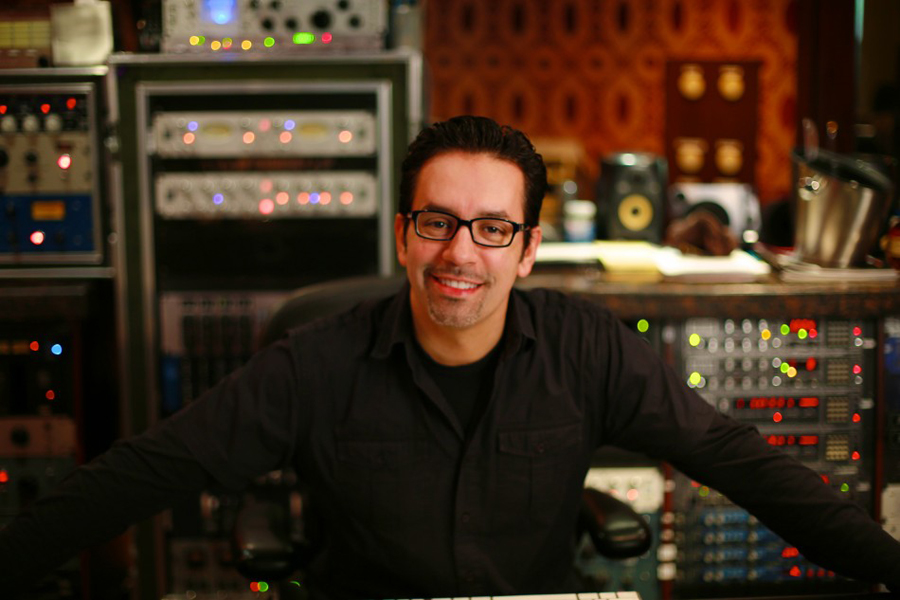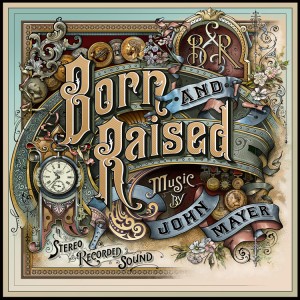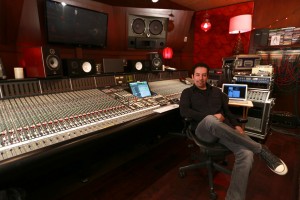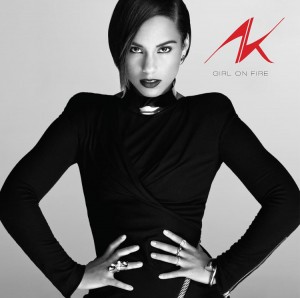Mixer Profile: Manny Marroquin Mixes Everything
In the last decade, as Manny Marroquin has been cranking out mixes for a growing client-base of pop stars, something has been stirring in the pop music world that is now in full effect. Sonically and stylistically, pop music has been hybridizing with artists embracing wide-ranging influences and sounds, mixing live instruments with computer music, and merging electronic dance music with all forms of songwriting. Other engineer/producers have struggled to evolve with this trend, but Marroquin was made for it – he’s kept his edge all along, and is now riding high.

Manny Marroquin. Photo by Brian A. Petersen.
Turn on Top 40 radio, and you’ll hear a Marroquin mix before too long, be it the latest singles by Bruno Mars, Kanye West, Justin Bieber, Alicia Keys, Taylor Swift, or Rihanna. But at the same time, Marroquin’s also drawing a cool mix of crossover clientele – John Mayer, Tegan and Sara, Lana Del Rey, Imagine Dragons, Crystal Fighters, and even The Rolling Stones. That’s right, Marroquin was recently hired by Don Was and the band to mix two brand new songs from one of rock music’s oldest institutions.
It is rare for a mixer to be so at home working with so many different genres of music, and to be at the forefront of each of them as well. Add to that that the majority of Marroquin’s workflow stays out-of-the-box (he loves his SSL 9000K), and one really wonders how he keeps up with the multitude of revisions and recalls clients have become so accustomed to. However his dedication to classic gear and techniques coupled with a thoroughly modern sound is what has become so appealing to contemporary talent.
When I sat down with him at Larrabee Studios, his home base, he was working simultaneously on an album from Enrique Iglesias and a Mariah Carey and Miguel collaboration (since released as #Beautiful ft. Miguel). So without further ado…
Seems like things are pretty busy around here!
Yeah, things have been good – and the Waves plug-ins [Marroquin’s Signature Series of Waves Plug-ins were released earlier this year] have been getting such good reviews from peers and blogs…
That, and every time I turn on the radio…
Oh yeah the music I’m working on right now! I feel really good about that. All the different genres; I’m a music fan first and foremost so to be able to work on Crystal Fighters one day to Ace Hood, which is really super hip-hop, to Enrique Iglesias, to Mayer Hawthorne; he’s a really cool artist. It’s really exciting. It’s been like this for a few years, but I’ve finally achieved the vision of being able to work on a variety of different things.
I don’t see as many guys doing cross-genre like you’ve been able to.
I actually don’t know. Yeah, I guess there aren’t many.
Did you get a lot of experience working on different types of music when you were coming up? How do you feel like you ended up here?
I think the main reason is just being a music fan. Getting up and listening to Spotify and iTunes, and keeping my ears open to cool new things that catch my attention. So that’s the number one, just being a fan and not discriminating. I can get into all kinds of music.

Marroquin mixed various tracks off Imagine Dragons’ Night Visions (KIDinaKORNER/Interscope).
And genres seem to be more closely related these days….
Yes! Totally true.
You look at the way people produce records now…
True, some of these mixers who get pigeonholed… I think there’s a reason for that; they probably wouldn’t embrace genres outside their comfort zone. Like I guarantee that (insert rock mixer name here) doesn’t listen to a lot hip-hop. He may appreciate it, or listen to it and be like “yeah it’s cool”, but not getting up in the morning and playing his album because he wants to. So being a music fan is definitely #1.
When I was growing up I played drums, and I played in a rock band. But all of my friends were listening to hip-hop, so then I would also play drums in hip-hop groups with a DJ. It was weird at the time but then it became a thing. So growing up a musician, and being around musicians all my life it opened me up to other things. I was able to appreciate a lot of different kinds of music at an early age. I also went to a music high school, Hamilton Music Academy, where one year all we would play was classical music, and the next year it was Jazz Band. Along with music appreciation classes, learning theory etc. So not only did I have the rock/pop/hip-hop background, but I was also getting exposed to things that I would never have been exposed as a part of school.
So with that background it was just a question of how to apply that to what’s coming out of the speakers. What I’ve been doing ever since I started mixing, almost 20 years now, is always listening for an emotion first. Being in the industry, we all always analyze everything, so I would ask myself, why does this song sound the way it does? Why does it make me feel the way it does? And the colors, what’s the focal point, why’s it doing this? Why is it making me feel a certain way? Subconsciously I’m always analyzing things that I like (and don’t like).
So now the application kicks in. So maybe you have an alternative song in front of you, you “access the hard-drive” in a way (laughs). You’re like, “Oh I remember the focal points of a song like this” because it reminds me of x, y and or z. The process of remembering how that feels gives me the ability to dive into it more confidently.
Totally, and it’s often surprising these days to hear what a given artist might really like – it’s often completely different from what you’d expect. Like a lot of “alternative” artists are inspired by hip-hop, So they’ll want some of that flavor in a completely different musical genre…
You’re absolutely right. I think that low end is one of the hardest things to control. You’ve got your kick, your sub, your bass, 808’s…all that stuff. There’s only so much room, so you have to know how to manipulate it, whether it’s EQ or compression. How do you maintain competitive volume with a lot of low-end information…when we’re in the loudness wars? There’s an to art figuring out how much of each thing we can get while still meeting those objectives. Years and years of hip-hop mixing kind of prepared me for some of the rock guys that are coming around now and do love hip-hop. Like I was working with this really cool band called Poliça from the Bon Iver camp. It’s a female singer, and she came in with some very hip-hop sounding tracks, but it was still an alternative record. It would be more challenging for a rock guy to control those low frequencies. If I mix an alternative type of song, the low end is the first thing I’m trying to chop, whereas with hip-hop it would be the opposite. So I have to figure out how to balance those two styles together.
I’ll tell you a story: The president of Interscope came in and said, “Manny there’s this band I’m really excited about and I want to play them for you.” So he came by and played me “We Are Young” by Fun. I’m not going to lie, I was blown away. I was like “ I don’t know what you just played me, but that is incredible.” So he played me like 4-5 songs. After he left I called up my manager and I was like “I think I just heard the future of alternative music.” It wasn’t like rock with guitars, it was just an attitude that didn’t have to do with traditional guitars and drums; it was just an emotion. It’s shifted certain things because now alternative music is playing more programmed stuff, but it’s still aggressive and creative. It’s like Kanye West coming out with 808’s and Heartbreak. That opened things up for all the rappers that wanted to be singing, and now you have a lot of that too. Like literally half of rappers now, if not more, are rapping and singing. I had that same feeling on seeing the future of where hip-hop was going when I was mixing that.
It makes sense that they are! And then, I listened to some of the last John Mayer record you did this morning (Born and Raised) and that is so organic; I kept having to check which tracks you mixed and which tracks Michael Brauer mixed… [Brauer and Marroquin split the mixing duties]

Marroquin shared mixing duties with Michael Brauer on John Mayer’s Born and Raised
Yeah, with that I had just finished Imagine Dragons, and then when I went on to Born and Raised I had to go with a totally different approach. It was like, forget what you just learned. Your knowledge of 2-bus compression on a track like Born and Raised doesn’t apply, you will kill the record if you’re too aggressive with it.
Yeah and the guy who mixes hip-hop or pop may be less comfortable handling that…
It might even sound “wrong” to his ears, he might feel like it had to be glued or compressed differently. And with that record, it’s the complete opposite – it needs to be un-hyped. And it definitely helped having an artist like John Mayer, who knows what he wanted as well. He would say “I want it to be like you’re on the top of a mountain in Montana looking at the sky, it’s 5 pm and the sun is starting to set and there’s a nice breeze; That’s what I want it to sound like.” I was like I don’t know why I know what you’re talking about, but I get it, I totally get it.
It’s a little harder when people don’t communicate and say, “Do what you do”. I’m not really here for my sound. I’m here for you. Where do you see it going? Let me help you get there. I feel like the artist/producer gets to the 15 yard line, and our job is to help them get into the end zone.
When you get an exciting record from the likes of Bruno Mars, John Mayer, or Alicia Keys it’s fun because you really get to interact with the artist. They’ll paint a picture for you. It’s what makes this job so cool and fun… and exhausting. You’re at full throttle the entire time. Like this Mariah thing right now [#Beautiful ft. Miquel], she comes in and stays until five in the morning…it’s intense to see that kind of dedication, and you see why she is who she is. It’s inspiring. I learn from that. If she’s there that late with that kind of dedication… So it’s a combination of all those little details, and therefore I’m the “flavor-of-the-month” I guess, until I get tired and the next guy comes along that has all those qualities and wants to work harder than me. (laughs)
Ok, so you’re working with all these clients nonstop and you are still mixing through the console…how do you do that??
Two great assistants! Everything goes through the board. So I’ll mix until I’m about 99% there and then I’ll have my guys print stems. While they do that I’ll be working on another track in a different room, or doing edits and updates. We live in the world of updates: “Can you do an update? a vocal up? a clean…etc” I’ll usually have my 2nd assistant do that. If there are more conceptual things that need to happen I’ll do it in a second room.
The stems usually sound about 98% there. We’ve got it down through trial and error; what combinations of hardware and plug-ins work well enough to always get back the glue you had on the board.
Do you print separate FX stems as well?
Yep. Like with Lana del Rey, her reverbs were so big – huge reverbs, almost uncomfortable at times. But after I got used to it and got into that mode it was fine. Since that was a big part of the production we were definitely printing all the reverbs separately. Because I know that if there’s ever a question mark on anything then I make a note and when it comes time to print I’ll have those tracks printed separately. A lot of the times I’ll sum elements together for the stems, like it’s three synthesizers that I don’t need to spread out on the board, then I’ll just put them out through two channels. Every track doesn’t go out individually, usually only 48 tracks worth. But I’ll definitely have the main elements like kick, snare, vocal.

Marroquin at his SSL 9000 K console at Larrabee Studios in L.A. Photo by Brian A. Petersen.
So given all those stems, do you ever need to do a full recall?
Man, last recall…I think it was like a Linkin Park song, and that was over a year ago. So, no, I really don’t recall.
That’s awesome, you’ve really got the stems working.
Recalls are definitely a thing of the past for me. Cause I’ll tell you what, even if I have a mix where I need, say the drums to have a different glue, and I can’t get it from the stems, I’ll just recall those channels and reprint the stem. So it’s not a full recall and it takes us ten minutes to do.
So you’ve never gotten the results you’ve wanted just going straight out of Pro Tools, or summing and using only plug-ins?
You know, I haven’t. For me, the power of doing more than one thing at a time is really special. I could be EQ’ing two things at once, or doing this [gesture of moving fader with one hand and EQ’ing with the other]. That human element alone is reason enough. I could be a creature of habit, and I know people may laugh when I say this, but there’s something very spiritual when something goes through you, to your brain, from a physical movement. I also work really fast, and being able to reach out and grab things makes that possible. I want to get those ideas out as fast as possible, those raw emotions, the feeling of that track. You want to get those ideas out of your head quickly. I’ll listen to the rough and want to throw faders up.
When I have tried to do it in the box it slows me down, because I can’t multi-task, you can only do one thing at a time. I’ve tried a workstation, but it didn’t work out because it wasn’t the same either. Sure I can do levels, but that’s about it, I can’t grab two EQ’s…That’s the biggest difference. Sonically, obviously there is a difference too, but I think you can probably work with that.
It’s gotten way better…
Way better. And people have gotten used to that sound too. That’s another thing, It’s not necessarily that it sounds better, it’s just that people are getting used to it. I remember people coming and saying, “Yeah we want it to sound really bright and harsh” and I was like, “But that’s the sound of ‘Tools”, and they were like, “Yeah we love that!”. So we’ve evolved into liking that sound, which is crazy…
It’s funny, people do so much themselves now, and many of the artists have gotten way better at doing their own production. So it actually has gotten a lot cleaner compared to 6-7 years ago. You get a rough from someone sometimes now and you’re like…
It sounds good! And you’re wondering what you can do with it…You’re right, all the lines are blurred now, I’m not just the mixer anymore. I’m also kind of mastering some of the stuff…sometimes I’m producing in a way too. The producer is mixing and performing, and so is the artist. All those lines that I knew have become very blurry. We’re all overlapping because of the technology. I remember 10-12 years ago working on drops [muting specific parts during mixing to create an arrangement], delay throws…all kinds of stuff that is already been done by the producer nowadays. All those things we were doing back then has been done for us. It’s almost pre-mixed sometimes when you get it. So it’s now your job to figure out how to get those last 15 yards. How do we get there?
Well you know how to add texture, the subtleties that people can’t clue into without old school experience….
Yeah, all the colors, and how they touch each other. Again, it may be 85-90% there when you get it, but that 10% makes a difference to the client, and that’s really all it is. If Alicia Keys can have a great rough, and then come in, hear my mix, and say “Wow, that’s incredible!” than I’ve done my job. Even though it may only be a 30% improvement, there is another emotion there that didn’t exist before, and that’s enough. You can’t put a number on that, that’s just what it is. If they could have done it themselves, they would have. You just have to respect that vision that the artist and producer have.
A good example of this would be Afrojack, the first mix I did for him was a Pitbull song, “Give Me Everything”. It was number one, and he sent me a two track, and then I had all the vocals on top of that. And of course I was ready to do it, but I asked him, for future songs, to send me a little more separate elements, if he wanted me to mess with it a little. So what I ended up doing was mult-ing the two track three or four times, EQ’ing and addressing each one differently, doing drops the old school way, and automating stuff on the actual channels. It was a pop song, so I had to create a lot of the interest that goes into a pop arrangement…only using the instrumental. I did it by filtering the verse, by adding a kick in one part, or by EQ’ing a bass in the bridge…something to make you feel like it was moving. He loved it.
Basically what I’m trying to say is that once people have trust, it becomes easier to work those situations. Today everyone has a Pro Tools rig and some kind of studio, so the producer and artist have control, they might not want to send their raw tracks if they’re happy with them. Especially if they don’t know you, that trust has to be built up. It’s just quality control.
People really have a better sense of what they want…
It’s kind of like we are sonic tastemakers. More than the actual mixing part, people just want to see what we think will work or not. Meaning sonic-scape, width, depth, dynamics. With a lot of today’s music how do you create the illusion of dynamics when sometimes it doesn’t really exist? It’s definitely a taste-making thing.
Back in the day mixers played a different role. I think a lot of guys transitioning from that time are realizing, OK, this is a new game, I can’t think of it as 1998 anymore. It’s a new world and a new way of thinking. Some people adjust to it and some don’t.
Also, people our age have some of the old and new ways…and a lot of that extra 15% comes from learning in that era, knowing where the real subtleties are that make the difference…
More happened in the last 15 years than in the previous 40. I’m lucky to have had that experience. That makes me a better mixer, understanding that world which we are often trying to re-create. Even now, Miguel is telling me to make his tambourine sound more like Van Morrison! It’s a unique situation that we’re in, still young enough to know that world, but not so old that we aren’t willing to adapt.
There is so much that applies to my everyday mixing that is coming from that analog world that’s ingrained in my mind and that I would love to re-create. I’m constantly chasing that.
Bo Boddie is a Grammy winning engineer/mixer and composer. Visit him at http://www.boboddie.com.
Please note: When you buy products through links on this page, we may earn an affiliate commission.








waltercruz
July 25, 2013 at 8:25 pm (12 years ago)Nice interview.
Marco
August 2, 2014 at 9:15 pm (11 years ago)Too bad the mastering guy of Girl on Fire destroyed the dynamic of the song.